Waarschuwing
Waarschuwingen
Type oefening
Wandel
Fiets
Presentatie
Kaart
Punten van interesse
Cirkwi's opdracht
Beoordelingen en recensies
Zie rondom
Wereldtentoonstelling van 1878


Credit : Musée carnavalet
De Cirkwi brief
Ontdek het hart van Parijs: een reis door de Wereldtentoonstelling van 1878
Met deze verleidelijke reis volgt u in de voetsporen van de Wereldtentoonstelling van 1878 en verkent u het historische Parijs en Courbevoie, gepresenteerd door de creatieve geest van Balades Fluviales Fabienne Lemoine, oprichter. Laat u onderdompelen in een verhaal dat teruggaat naar een cruciale gebeurtenis in de geschiedenis van Parijs, waar innovatie en schoonheid op een ongekende schaal samenkomen. Maak een ontspannen wandeling langs de bezienswaardigheden die de grootsheid van het verleden weerspiegelen en ervaar de essentie van Parijs naast overblijfselen die de tand des tijds hebben doorstaan. Dit avontuur belooft meer dan een rondleiding; het is een portaal naar het verleden, met zorg samengesteld voor nieuwsgierigen en dromers.
Essentiële technische routebeschrijving
Deze route bestrijkt een totale afstand van ongeveer 10,78 km, met een hoogteverschil dat u van 24 meter op het laagste punt naar 65 meter op het hoogste punt brengt. U zult een zachte en glooiende reis ervaren, met een totale positieve hoogteverandering tussen 153 en 143 meter. De aangewezen route is voornamelijk geschikt voor voetgangers, waardoor het een ideale route is voor degenen die genieten van wandelen. Perfect geschikt voor een dagje verkennen, biedt het een toegankelijk avontuur voor deelnemers van verschillende fitnessniveaus, met een mix van prachtige uitzichten en historisch inzicht.
Seizoensgebonden tips voor ontdekkingsreizigers
Om optimaal van uw ervaring te genieten, is het belangrijk om geschikt gekleed te gaan voor de gelegenheid en het seizoen. De lente en herfst in Parijs hebben milde temperaturen die ideaal zijn voor lange wandelingen, terwijl de warmte van de zomer een rustiger tempo met talloze pauzes in de schaduw mogelijk maakt. De winters zijn kouder, maar hebben minder drukte - zorg er gewoon voor dat u laagjes draagt. Ongeacht het seizoen zijn comfortabele wandelschoenen een must. Wat betreft veiligheid, blijf altijd alert op uw omgeving, vooral in drukke stadswijken. Neem water en misschien een snack mee en laat het weer van de dag uw inpakken begeleiden - zonnebrandcrème voor zonnige dagen en een regenjas voor de onvoorspelbare Parijse buien.
Parijs en Courbevoie: een rijke lappendeken
Deze reis neemt u mee door het hart van Parijs, een stad die synoniem staat voor historische diepgang en architectonische grootsheid, en strekt zich uit tot Courbevoie, waarin diverse lagen van het erfgoed van de Franse hoofdstedelijke regio te ontdekken zijn. Parijs omvat binnen zijn compacte indeling monumentale locaties die belangrijke wereldwijde dialogen hebben gehost, zoals de grote tentoonstellingen. Courbevoie, vaak overschaduwd, dient als een vitaal historisch en cultureel satelliet van de metropool. Deze regio, die de essentie van menselijke prestaties en artistieke expressie omvat, is een getuigenis van de veerkracht en vindingrijkheid van de menselijke geest, zoals tentoongesteld tijdens de Wereldtentoonstelling van 1878.
Weer inzichten: plan uw bezoek
Het klimaat in Parijs kan breed worden ingedeeld als gematigd, met verschillende seizoenen die gevarieerde ervaringen bieden. De winters zijn koud met af en toe vorst, terwijl de zomers warm en soms vochtig kunnen zijn. De lente en herfst bieden het meest aangename weer, gekenmerkt door milde temperaturen en zachte briesjes - perfect voor wandeltochten. Gezien dit klimaattafereel zijn late lente (mei tot juni) en vroeg in de herfst (september tot oktober) de ideale tijden om aan deze historische reis te beginnen. Het weer is dan perfect geschikt voor buitenverkenningen, wat zorgt voor een comfortabele en verrijkende ervaring.
Met deze verleidelijke reis volgt u in de voetsporen van de Wereldtentoonstelling van 1878 en verkent u het historische Parijs en Courbevoie, gepresenteerd door de creatieve geest van Balades Fluviales Fabienne Lemoine, oprichter. Laat u onderdompelen in een verhaal dat teruggaat naar een cruciale gebeurtenis in de geschiedenis van Parijs, waar innovatie en schoonheid op een ongekende schaal samenkomen. Maak een ontspannen wandeling langs de bezienswaardigheden die de grootsheid van het verleden weerspiegelen en ervaar de essentie van Parijs naast overblijfselen die de tand des tijds hebben doorstaan. Dit avontuur belooft meer dan een rondleiding; het is een portaal naar het verleden, met zorg samengesteld voor nieuwsgierigen en dromers.
Essentiële technische routebeschrijving
Deze route bestrijkt een totale afstand van ongeveer 10,78 km, met een hoogteverschil dat u van 24 meter op het laagste punt naar 65 meter op het hoogste punt brengt. U zult een zachte en glooiende reis ervaren, met een totale positieve hoogteverandering tussen 153 en 143 meter. De aangewezen route is voornamelijk geschikt voor voetgangers, waardoor het een ideale route is voor degenen die genieten van wandelen. Perfect geschikt voor een dagje verkennen, biedt het een toegankelijk avontuur voor deelnemers van verschillende fitnessniveaus, met een mix van prachtige uitzichten en historisch inzicht.
Seizoensgebonden tips voor ontdekkingsreizigers
Om optimaal van uw ervaring te genieten, is het belangrijk om geschikt gekleed te gaan voor de gelegenheid en het seizoen. De lente en herfst in Parijs hebben milde temperaturen die ideaal zijn voor lange wandelingen, terwijl de warmte van de zomer een rustiger tempo met talloze pauzes in de schaduw mogelijk maakt. De winters zijn kouder, maar hebben minder drukte - zorg er gewoon voor dat u laagjes draagt. Ongeacht het seizoen zijn comfortabele wandelschoenen een must. Wat betreft veiligheid, blijf altijd alert op uw omgeving, vooral in drukke stadswijken. Neem water en misschien een snack mee en laat het weer van de dag uw inpakken begeleiden - zonnebrandcrème voor zonnige dagen en een regenjas voor de onvoorspelbare Parijse buien.
Parijs en Courbevoie: een rijke lappendeken
Deze reis neemt u mee door het hart van Parijs, een stad die synoniem staat voor historische diepgang en architectonische grootsheid, en strekt zich uit tot Courbevoie, waarin diverse lagen van het erfgoed van de Franse hoofdstedelijke regio te ontdekken zijn. Parijs omvat binnen zijn compacte indeling monumentale locaties die belangrijke wereldwijde dialogen hebben gehost, zoals de grote tentoonstellingen. Courbevoie, vaak overschaduwd, dient als een vitaal historisch en cultureel satelliet van de metropool. Deze regio, die de essentie van menselijke prestaties en artistieke expressie omvat, is een getuigenis van de veerkracht en vindingrijkheid van de menselijke geest, zoals tentoongesteld tijdens de Wereldtentoonstelling van 1878.
Weer inzichten: plan uw bezoek
Het klimaat in Parijs kan breed worden ingedeeld als gematigd, met verschillende seizoenen die gevarieerde ervaringen bieden. De winters zijn koud met af en toe vorst, terwijl de zomers warm en soms vochtig kunnen zijn. De lente en herfst bieden het meest aangename weer, gekenmerkt door milde temperaturen en zachte briesjes - perfect voor wandeltochten. Gezien dit klimaattafereel zijn late lente (mei tot juni) en vroeg in de herfst (september tot oktober) de ideale tijden om aan deze historische reis te beginnen. Het weer is dan perfect geschikt voor buitenverkenningen, wat zorgt voor een comfortabele en verrijkende ervaring.
Automatisch gegenereerd.
IGN kaarten
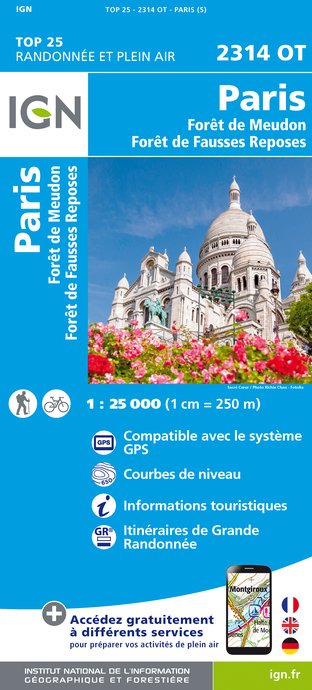
2314OT - PARIS FORÊT DE MEUDON FORÊT DE FAUSSES REPOSES
Uitgever : IGN
Verzameling : TOP 25 ET SÉRIE BLEUE
Ladder : 1:25 000
13.90€

190 PARIS CHANTILLY FONTAINEBLEAU
Uitgever : IGN
Verzameling : TOP 100
Ladder : 1:100 000
8.40€

118 PARIS CHARTRES PNR DE LA HAUTE VALLÉE DE CHEVREUSE
Uitgever : IGN
Verzameling : TOP 100
Ladder : 1:100 000
8.40€
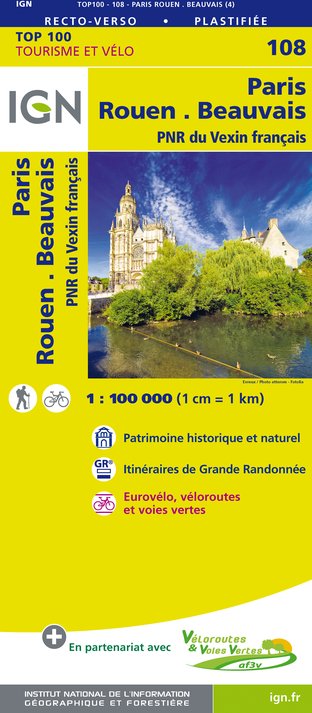
108 PARIS ROUEN BEAUVAIS PNR DU VEXIN FRANÇAIS
Uitgever : IGN
Verzameling : TOP 100
Ladder : 1:100 000
8.40€
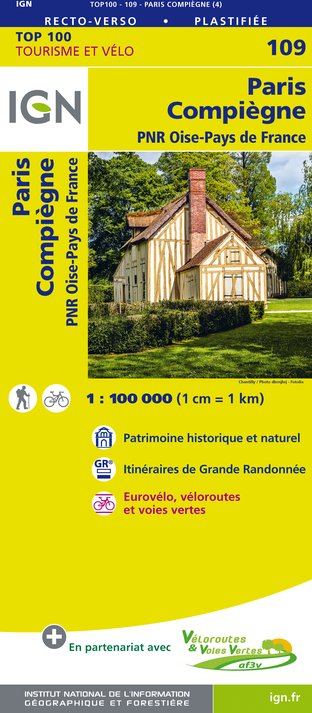
109 PARIS COMPIÈGNE PNR OISE-PAYS DE FRANCE
Uitgever : IGN
Verzameling : TOP 100
Ladder : 1:100 000
8.40€
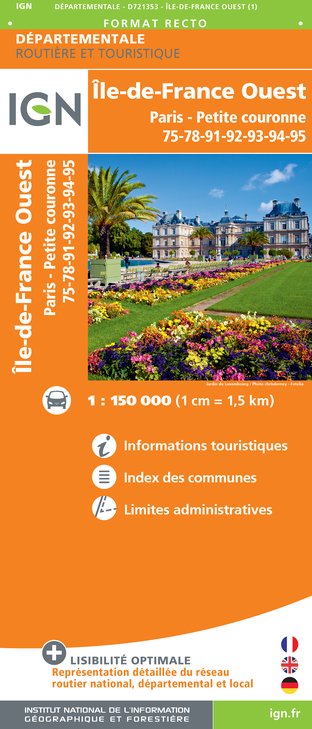
D75-95 ÎLE-DE-FRANCE OUEST
Uitgever : IGN
Verzameling : CARTES DÉPARTEMENTALES IGN
Ladder : 1:150 000
5.90€

D77 SEINE-ET-MARNE
Uitgever : IGN
Verzameling : CARTES DÉPARTEMENTALES IGN
Ladder : 1:150 000
5.90€

D28 EURE-ET-LOIR
Uitgever : IGN
Verzameling : CARTES DÉPARTEMENTALES IGN
Ladder : 1:150 000
5.90€

NR01 HAUTS-DE-FRANCE
Uitgever : IGN
Verzameling : CARTES RÉGIONALES IGN
Ladder : 1:250 000
6.80€

NR08 CENTRE-VAL DE LOIRE
Uitgever : IGN
Verzameling : CARTES RÉGIONALES IGN
Ladder : 1:250 000
6.80€

NR03 ÍLE DE FRANCE
Uitgever : IGN
Verzameling : CARTES RÉGIONALES IGN
Ladder : 1:250 000
6.80€
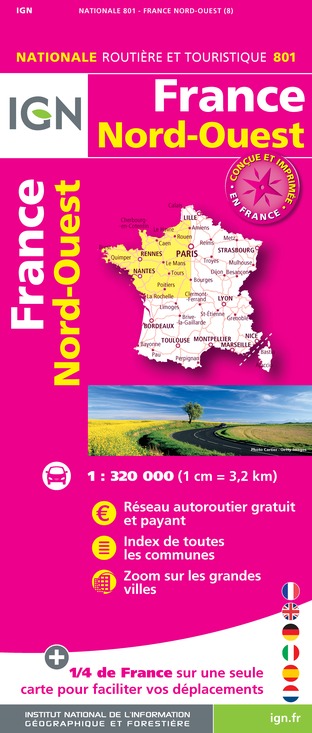
801 FRANCE NORD OUEST
Uitgever : IGN
Verzameling : CARTES NATIONALES IGN
Ladder : 1:320 000
6.10€

EUROPE
Uitgever : IGN
Verzameling : DÉCOUVERTE DES PAYS DU MONDE IGN
Ladder : 1:2 500 000
7.00€
Technische informatie
Wandel
Moeilijkheid
Niet gespecificeerd
Afstand
11 km
Type oefening
Wandel
Fiets
Meer informatie tonen
Hoogteprofiel
Startpunt
75007
Paris
Lat : 48.86047Lng : 2.32498
Punten van interesse
Gegevensauteur
Beoordelingen en recensies
Om te zien rondom







